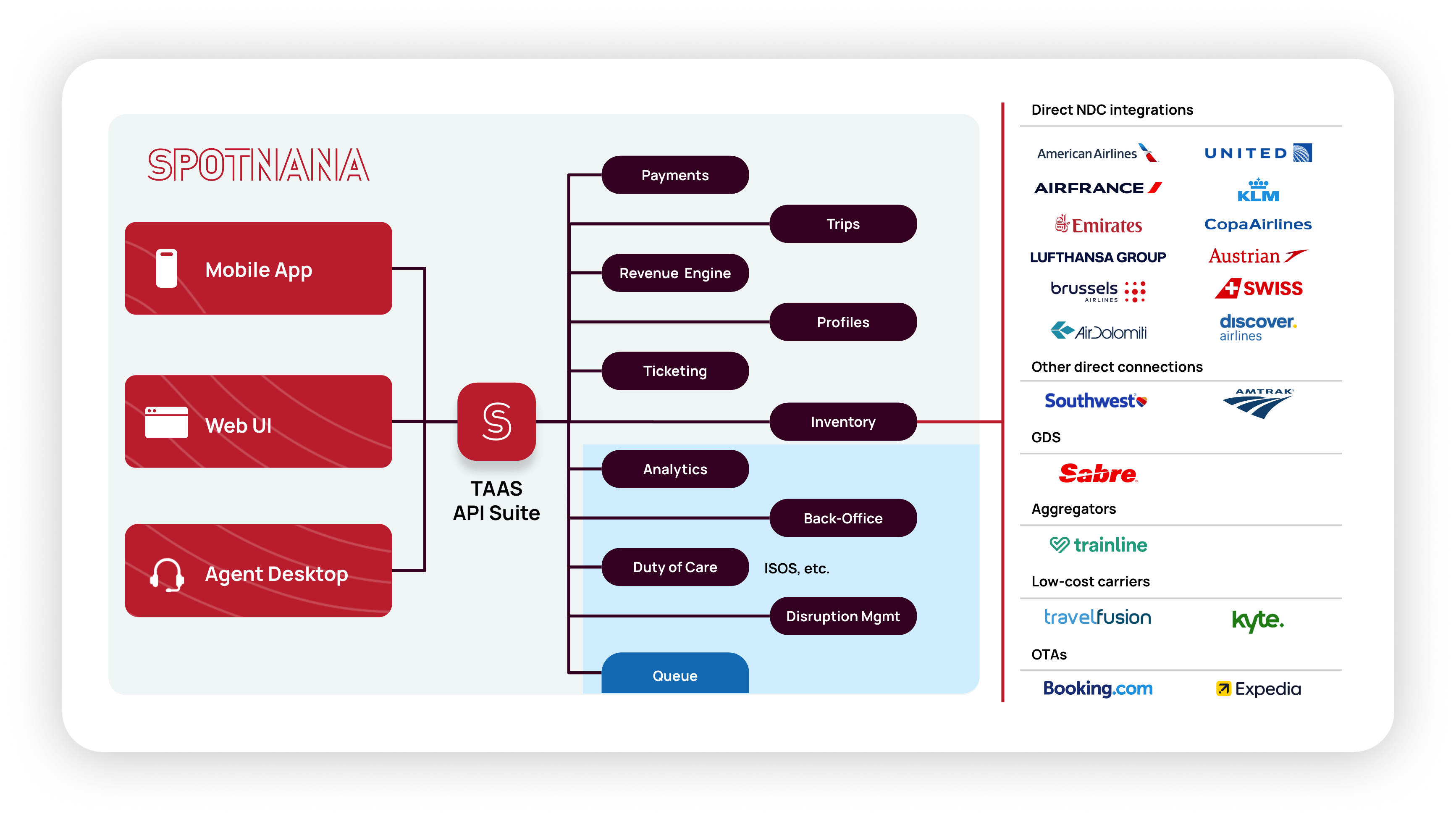A recent topic of conversation in corporate travel has been the industry’s need for tech-driven innovation. We heard this quite frequently at the 2024 Global Business Travel Association Convention, where the Direct Travel team debuted our next-generation travel tech solution: Avenir.
 Avenir is the next step we’re taking in pursuit of The Perfect Trip. Its release comes at a time when our team is well positioned and prepared to embrace change, and we share our customers’ sense of excitement for what the future holds. (In fact, “avenir” even means “future” in French!)
Avenir is the next step we’re taking in pursuit of The Perfect Trip. Its release comes at a time when our team is well positioned and prepared to embrace change, and we share our customers’ sense of excitement for what the future holds. (In fact, “avenir” even means “future” in French!)
Avenir: Travel Edition is a next-generation travel platform powered by cutting-edge technology from Spotnana and backed by Direct Travel’s unmatched service. Let’s dive deeper into Spotnana, which is the first phase of Avenir to come online. This is essential, because as you’ll see below, their Travel-as-a-Service platform provides the critical modern “plumbing” and infrastructure needed to drive a new level of innovation.
What is Spotnana?
Note: This article was originally published on spotnana.com, which we’ve republished and modified below to address the Direct Travel audience.
The question of what Spotnana is has come up in many conversations with Direct Travel clients. People want to know if Spotnana fits in one of the standard industry categories:
- Online booking tool (OBT) provider – a company that makes software for booking travel and managing trips online.
- Travel content aggregator – a business that focuses on building direct integrations with airlines, hotels, and other travel suppliers, aggregating their inventory of travel content (prices, availability, descriptions, images, etc.) and then distributing that content to other businesses that sell travel.
- Travel technology provider – a company with APIs for powering travel experiences embedded in another company’s products or digital experiences.
If you don’t already have a background in the travel industry, you might be confused by this terminology and acronyms like OBT, GDS, NDC, etc. Every industry has its acronyms and jargon. The truth is Spotnana encompasses many of these categories and more.
At the end of the day, what people really want to know is “what does Spotnana do?” The simplest answer is that our partners at Spotnana are building new modern infrastructure for the trillion-dollar travel industry, which relies heavily on technology and data structures that were developed several decades ago.
Spotnana’s cloud-based platform pulls together a massive amount of travel content in real time from a wide range of suppliers and aggregators, makes corporate and leisure travel options available through a modern shopping experience, enables travel agents to provide assistance in a highly efficient manner when needed, and gives corporate travel managers the ability to reduce travel costs through policies and negotiated discounts. Their platform is also built with an API-first architecture and designed to be white labeled, embedded, and deeply integrated with other software products, websites, and mobile apps.
An Illustrative Analogy – AWS and Amazon
Before we dig deeper into what Spotnana specifically does, a quick analogy might be helpful.
We’re all pretty familiar with Amazon’s cloud computing platform, Amazon Web Services (AWS). AWS offers both Infrastructure-as-a-Service (IaaS), where companies can access raw machines, and they offer Platform-as-a-Service (PaaS) with a range of managed capabilities. But in a more general sense, AWS is a platform on which others can build.
AWS offers various components like databases, storage, compute power, AI/ML modules, and authentication services. Any company can mix-and-match these to build their own offerings. The first user of AWS was actually Amazon itself for its e-commerce offering. Over time, this cloud-based infrastructure was made available to others.
In a similar way, Spotnana has introduced a first-of-its-kind cloud-based technology stack for travel called Travel-as-a-Service. They offer a wide range of components that can be sold as a complete out-of-the-box travel solution or embedded in a third-party offering.
Examples of Spotnana’s components include search APIs (for flights, hotels, cars, and rail bookings), a Content Engine for aggregating, deduping, and normalizing travel content, a System of Record for managing transaction data and analytics, a Booking Engine that uses microservices to automate complex workflows like self-service flight changes, an Agent Desktop for travel agents to provide assistance to travelers, and a series of embeddable UI components that can be assembled into an Online Booking Tool or a white labeled shopping experience.
Explaining Travel Industry Jargon
Before we dive deeper into how Spotnana serves so many different travel roles (OBT, travel content aggregator, and travel technology provider), let’s define some key travel concepts and terminology.
Travel Suppliers and Content Distribution
Suppliers are the entities that provide the travel inventory to be booked by travelers. Think of airlines, hotel chains, car rental companies, and railways, for example. There are over a million hotel properties and over 500 airlines. How is all their inventory made available for booking by billions of travelers in real-time?
Similar to other industries, this is where distribution channels come in. Distribution channels for travel content can be direct or indirect. Direct channels are integrations built to supplier-specific APIs, and indirect channels are integrations built to various forms of content aggregators. All of these are briefly discussed below.
Direct Distribution Supply Channels
- Direct APIs – an API (Application Programming Interface) at its simplest form allows two software components to communicate with each other. Some suppliers offer APIs that anyone can use to access their inventory, which is called a Direct API.
- New Distribution Capability (NDC) API – NDC is an initiative launched by the airline industry to create APIs that follow a standard data schema. This replaces an older data standard called EDIFACT, which was very limiting – for example, airlines could only create 26 different offers at any given time because EDIFACT was limited to the 26 letters in the alphabet. The change from EDIFACT to NDC is driving a massive disruption in the airline industry similar to when the music industry shifted from CDs to online streaming services. Spotnana is helping to accelerate this change.
Indirect Distribution Supply Channels
- Aggregator – these companies build direct integrations to multiple suppliers of the same type, such as airlines or hotels. They then offer a single API or portal through which companies can book inventory.
- Global Distribution System (GDS) – these are systems that aggregate content from many types of suppliers (airlines, hotels, car, and rail) as well as aggregators to make it easier for TMCs and OBT providers to access a wide range of travel inventory through a single source. Examples of GDSs include Sabre, Amadeus, and Travelport.
Suppliers can choose to distribute their content through multiple approaches. For example, Southwest Airlines uses GDSs and a Direct API, and United Airlines uses GDSs and NDC.
How Spotnana is Modernizing Travel Infrastructure
Spotnana has taken a very different approach. They have built their own technology for managing bookings, they use databases and buses to move data between microservices in their platform, and they use APIs tied to their System of Record to pass data between systems. Spotnana’s architecture treats GDSs as one source of content among many, and where beneficial they build direct integrations to suppliers and aggregators.
Here is a diagram that summarizes how Spotnana’s Travel-as-a-Service platform is architected:

As you can see, Spotnana provides a combination of self-service and assisted travel shopping experiences that are built on an API-first architecture that uses microservices to automate workflows and integrate a vast range of sources of travel inventory.
While this may seem simple and straightforward, in the travel industry it is revolutionary. The challenges Spotnana has had to navigate to pull content together from so many sources in real-time – with all inventory aggregated, deduped, normalized, sorted, filtered, and marked up with customer-specific business rules for what is considered in and out of policy – rival the complexity of the world’s largest e-commerce platforms.
Their unique architecture gives them tremendous advantages in the travel industry. With Spotnana, customers and partners get access to more content, more flexibility to manage bookings on their own, better service experiences, and a greater ability to ensure travel programs save time and money. Spotnana’s architecture also enables them to innovate much faster than providers of alternative solutions.
While they’ve made tremendous progress delivering on their mission to modernize the infrastructure of the travel industry, the truth is they are just getting started, and the most challenging and exciting problems from a technology perspective are still yet to be solved.
In Pursuit of The Perfect Trip
Today’s deep dive into Spotnana is the first blog in a series – stay tuned as we explore how each of our key technology partners are coming together to help us set a new standard in business travel. Sign up for our newsletter to learn more about how Avenir can transform your travel program.




